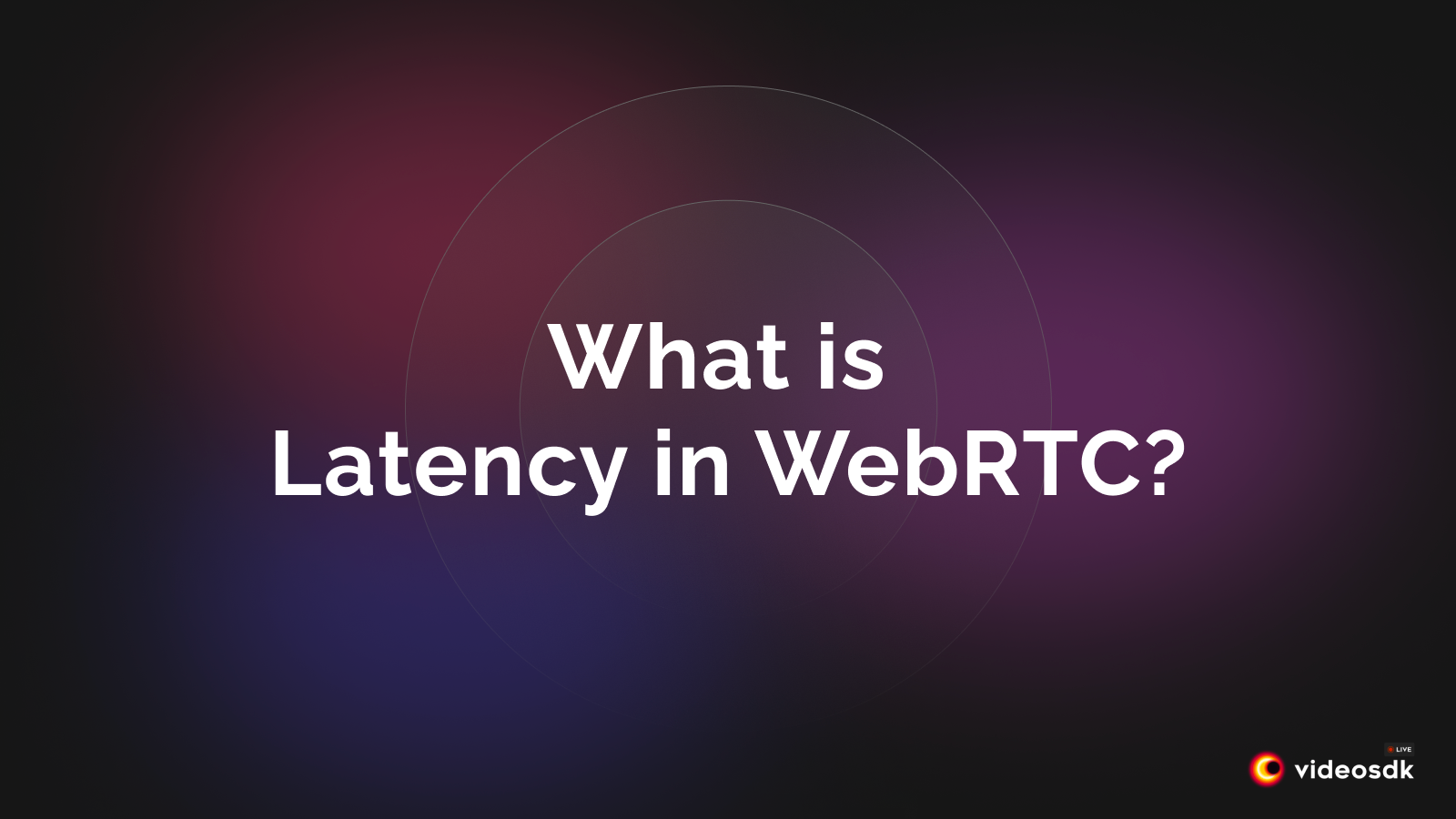What is Latency?
Latency refers to the time delay between the initiation of a process means it starting point and its completion means its endpoint. In the context of real-time communication, minimizing latency is crucial for achieving optimal user experiences. Whether it's video conferencing or live streaming, minimizing latency ensures smoother and more engaging interactions.
What is Latency in WebRTC?
In WebRTC (Web Real-Time Communication), latency refers to the time delay between the transmission of data from one endpoint to another within a real-time communication session, such as video or audio conferencing, over the internet. Latency in WebRTC is characterized by three main components:
- Transmission Delay: The time it takes for data to travel from the sender to the receiver.
- Processing Delay: The time spent encoding and decoding audio and video data.
- Propagation Delay: The time it takes for data to traverse the network.
The Role of WebRTC and the Critical Need for Low Latency
WebRTC enables real-time communication directly between web browsers, facilitating applications such as video conferencing, online gaming, and live streaming. Low latency is of paramount importance in WebRTC as it directly impacts the user experience. Reduced latency ensures that communication feels natural and instantaneous, crucial for applications where responsiveness is key.
Exploring Causes of Latency in WebRTC: Challenges and Solutions
Several factors contribute to internet latency in the context of WebRTC, each posing unique challenges to developers.
Network Congestion
Network congestion occurs when the available bandwidth is insufficient to handle the volume of data being transmitted. This can result in delays and disruptions in audio-video communication. VideoSDK addresses this challenge by incorporating adaptive algorithms that optimize real-time video streaming even in congested network conditions.
Packet Loss
Packet loss refers to the loss of data packets during transmission. In WebRTC, packet loss can lead to jittery video and audio playback, degrading the overall quality of the user experience. VideoSDK tackles this issue by implementing adaptive bitrate streaming, dynamically adjusting the quality of the stream to compensate for packet loss, and ensuring a smooth and uninterrupted experience for users.
Jitter
Jitter is the variation in the arrival time of data packets. In WebRTC, jitter can result in synchronization issues and disrupt the flow of real-time communication. VideoSDK mitigates jitter by incorporating advanced mechanisms that compensate for variations in packet arrival times, maintaining a consistent and smooth streaming experience.
Comparing Latency: WebRTC Versus Other Streaming Protocols
WebRTC (Web Real-Time Communication) is renowned for its low-latency capabilities, making it well-suited for real-time communication applications. When compared to other streaming protocols, WebRTC generally excels in minimizing latency, especially in scenarios like video conferencing and live broadcasting. Let's briefly compare WebRTC latency to some other streaming protocols:
WebRTC vs. HLS (HTTP Live Streaming)
WebRTC offers lower latency compared to traditional HLS. HLS typically introduces latency in the range of several seconds due to its chunked delivery mechanism, while WebRTC can achieve much lower latency, often in the range of milliseconds to a few seconds.
WebRTC vs. RTMP (Real Time Messaging Protocol)
RTMP has been widely used for live streaming, but it can introduce noticeable latency. WebRTC, in contrast, is designed for real-time communication and can provide lower latency, making it a preferred choice for applications requiring quick and responsive interactions.
WebRTC vs. MPEG-DASH (Dynamic Adaptive Streaming over HTTP)
Similar to HLS, MPEG-DASH can introduce latency due to its segment-based delivery. When combined with Low-Latency CMAF (Common Media Application Format), MPEG-DASH can achieve reduced latency, but WebRTC often outperforms it in terms of real-time responsiveness.
WebRTC vs. SRT (Secure Reliable Transport)
Both WebRTC and SRT focus on low-latency streaming, but they have different use cases. WebRTC is commonly associated with real-time communication on the web, while SRT is often used for secure and reliable video streaming over unreliable networks. The choice between them depends on the specific requirements of the application.
WebRTC vs. QUIC (Quick UDP Internet Connections)
WebRTC and QUIC both aim to reduce latency, but they have different focuses. WebRTC is designed for real-time communication, while QUIC is a general-purpose transport protocol that can benefit various web applications, including streaming. The specific use case and requirements influence the choice between WebRTC and QUIC.
How VideoSDK Optimizes WebRTC for Reduced Latency?
VideoSDK
VideoSDK is a comprehensive live video infrastructure designed for developers across the USA & India. It offers real-time audio-video SDKs that provide complete flexibility, scalability, and control, making it seamless for developers to integrate audio-video conferencing and interactive live streaming into their web and mobile applications.
Features of VideoSDK
- Low-latency streaming capabilities: VideoSDK is engineered to deliver low-latency streaming, ensuring minimal delays in audio-video communication. This is particularly crucial for applications where real-time interaction is paramount.
- Adaptive bitrate streaming: VideoSDK employs adaptive bitrate streaming, dynamically adjusting the quality of the video stream based on network conditions. This not only mitigates the impact of packet loss but also ensures a consistent viewing experience for users across varying internet speeds.
IImplementing VideoSDK to Combat Latency Issues in WebRTC
- Real-time video optimization: VideoSDK optimizes real-time video streaming by minimizing transmission and processing delays. This is achieved through advanced encoding and decoding algorithms, ensuring a smooth and responsive user experience.
- Adaptive algorithms for network conditions: VideoSDK's adaptive algorithms intelligently adapt to changing network conditions, optimizing the audio-video stream in real time. Whether faced with network congestion or packet loss, VideoSDK dynamically adjusts, ensuring a reliable and low-latency connection.
In the dynamic landscape of real-time communication, addressing latency is paramount for developers aiming to provide optimal user experiences. VideoSDK stands out as a powerful ally, offering a comprehensive solution to mitigate latency challenges in WebRTC. By integrating VideoSDK into their applications, developers can unlock the full potential of real-time audio-video communication, providing users with a seamless and immersive experience. It's time for developers to explore the possibilities that VideoSDK opens up and elevate their applications to new heights of performance and user satisfaction.
